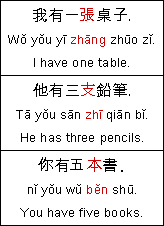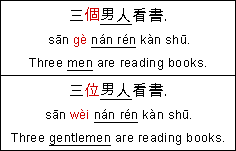




In English, we often count in units, for example:
The Chinese language also uses words like "pair" and "case" when counting one or more instance of an object. In Chinese, though, these measure or "counting" words must be used every time objects are being counted, whether just one pencil or 1.5 billion people.
Different measure words are
used for different kinds of objects. For instance, large flat objects are counted
with (zhāng);
long round objects use
(zhī).
Each measure word comes between the number of objects and the name of the object.
Here are a few sentences showing counting words in action. The counting words and their pinyin translations are colored red to help you pick them out. Otherwise, the word order of the Chinese and English sentences are once again parallel.

The most commonly used measure word is
(gè). This also just happens to be the one normally used to count people, except
when being extra polite, then we use
(wèi). You might remember the difference between
(gè) and
(wèi) as
the difference between 'women' and 'ladies', between 'men' and 'gentlemen', and
between 'customer' and 'guest'.

Now
please don't tell your Chinese language teacher that I'm the one who told you
this, but if you're out and about where Chinese is the native language and you
can't remember or don't know the proper measure word for some kind of item, you
will probably be understood if you use
(gè) instead. Just don't make a permanent habit of it. Do this only until you
have learned the correct measure word.
If you're lucky, the person you're talking to might politely correct you and, consequently, teach you the proper counting word. That's how I learned many of them, from shopkeepers and waitresses working near Fuzhou University in China's Fujian Province.